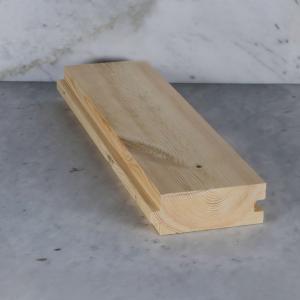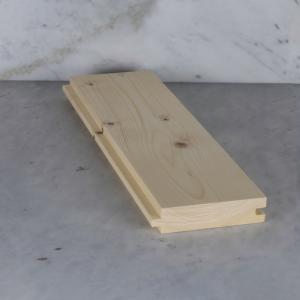What is the difference between pine flooring and spruce flooring?
A solid wooden floor made of pine or spruce is made from whole wood slats with natural grain, unlike, for example, parquet which consists of several layers. The whole wood planks provide a beautiful floor that can be sanded as needed and treated in various ways.
Choosing pine or spruce flooring is mainly a matter of taste, the different materials do not significantly differ in durability, and both provide a naturally warm feeling. Follow our guide to choose the right floor for you, maybe you want to install completely new flooring or maybe you just want help in identifying an existing wooden floor?
Appearance - Pine Flooring
Pine flooring is characterized by distinct graining (lighter wood with a darker core). The knots are fewer but larger and tend to have an oval shape. Pine can also be perceived as somewhat warmer in tone than spruce from the beginning, which is enhanced over time. A pine floor with clear varnish will acquire a red hue over time.
Appearance - Spruce Flooring
Spruce flooring is not quite as contrast-rich as pine flooring. The spruce's many branches result in more but smaller knot marks, which are also not as dark as those in pine. Spruce is a lighter type of wood that remains relatively pale over time. Spruce flooring with a clear varnish will develop a yellow hue rather than red.
Treatment - Wooden Flooring
A wooden floor, whether pine or spruce, needs to be treated to be resilient and withstand daily use. Depending on the finish you desire - whether you want to retain the wood's own natural color or if you want to pigment it, there are a multitude of options. Here we help to clarify the concepts!
Wedge cut wooden Floors
Before the mid-19th century, wedge cut wooden flooring was common. Underfloors were rarely used, and the flooring was laid directly on the joists. The wedge shape arose because the entire tree trunk, which was wider at the bottom and narrower towards the top, was utilized. The boards were laid alternately and usually in full lengths. The boards came from spruce or pine and were relatively wide.
Width and Thickness
In the second half of the 19th century, it became possible to cut the planks mechanically, which produced even, parallel floorboards. From this time, the wooden planks also became narrower, between 100 - 140 mm. In more elaborate buildings, long floorboards without end joints were often laid. Along the walls, the floor was commonly framed with a border consisting of a simple, slightly wider, floorboard. Hearthstones in front of fireplaces and tile stoves were also often equipped with a border.
Even though the floorboards became narrower, they did not become thinner. We recommend a wooden floor with a thickness of at least 25 mm, as a sturdier floor can withstand wear over time and can be sanded and treated multiple times.
Moisture Content
We offer floors in two different drying levels - choose between approx 9% and 12% moisture content. Floors with a 12% moisture content will acclimatize during installation (shrink), which allows for the time typical gaps to appear. Floors with an 8-10% moisture content are less affected in a normal indoor climate and can also withstand underfloor heating.








